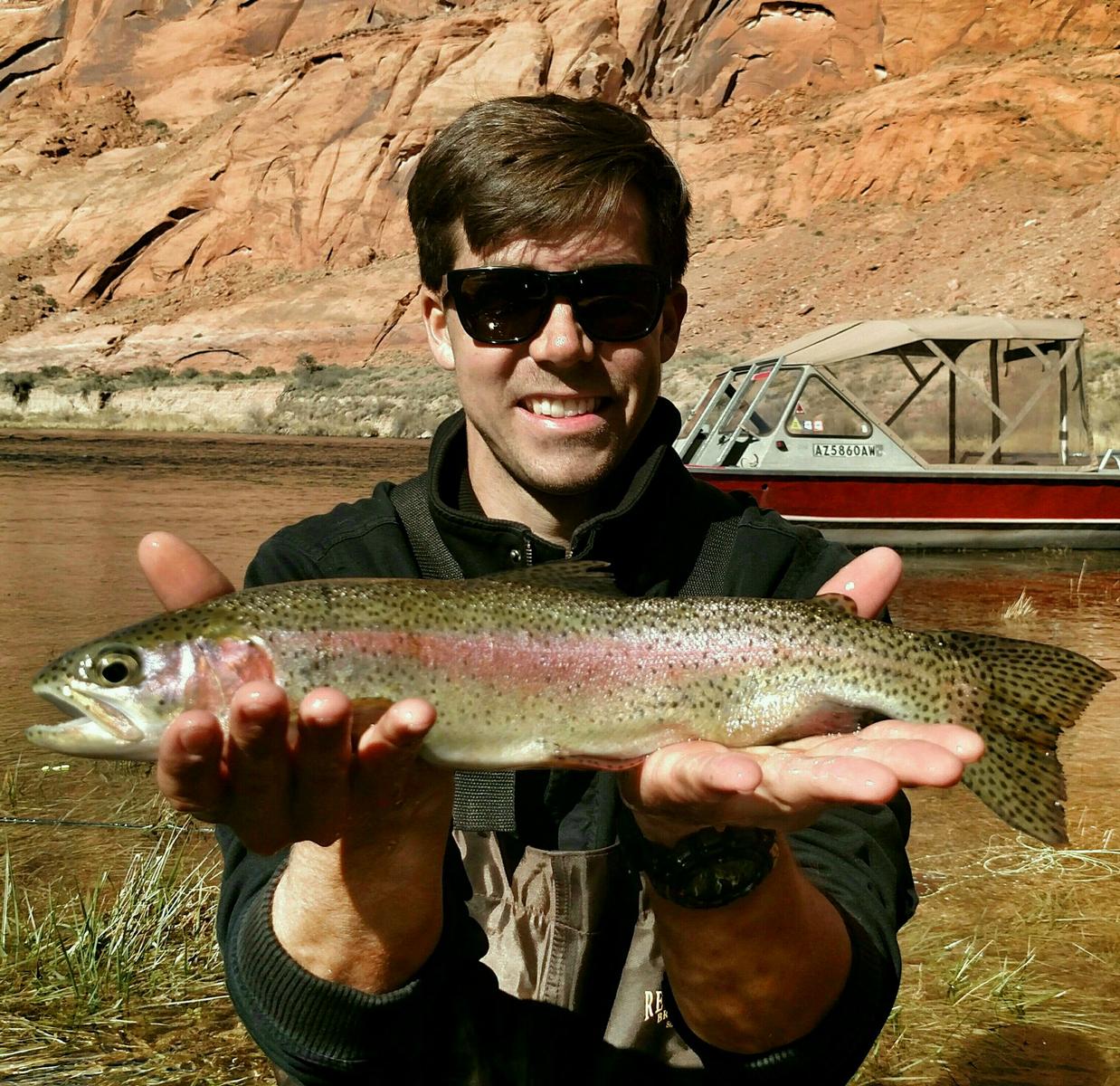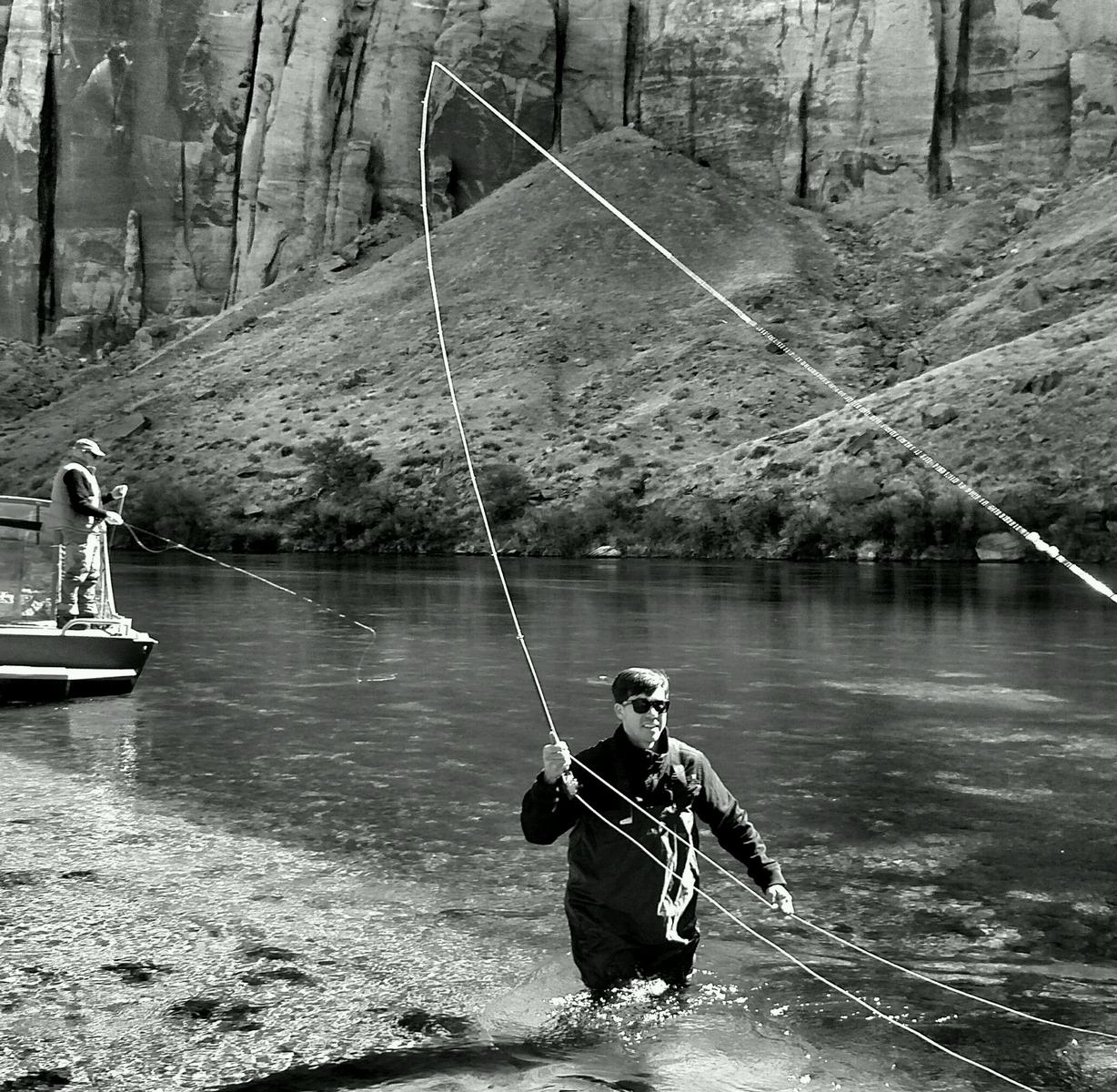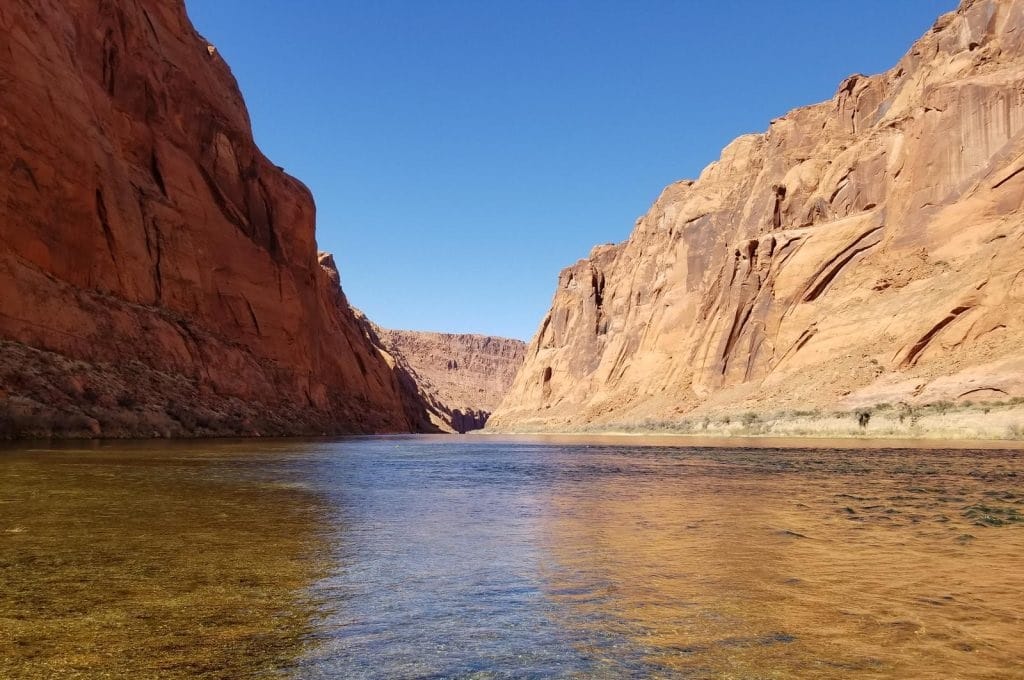Lees Ferry is considered one of the Blue Ribbon Trout fisheries in the United States. The water runs gin clear for the most part with only the deepest pools causing you to lose sight of the bottom. You can see the fish and there are several hundred to see in the fourteen miles of river running from the boat put into the Glen Canyon Dam face.
Location
Northern Arizona just below the Utah border is the setting for Lees Ferry. It is in the Vermilion Cliffs Wilderness. Turn off Hwy 89 to Hwy 89A just below Page, AZ. and drive 14 miles to Marble Canyon where the turn-off into the Park starts.
The 89/89A junction is 25 miles South of Page which is the entry city for Lake Powell. The GPS location of Lees Ferry boat ramp and walk-in fishery is 36.865816, -111.586503

Description
First time fishermen going upriver have a hard time remembering they came to fish. The setting is spectacular and breathtaking. The high vermillion cliffs that rise hundreds of feet from both sides of the river are awe inspiring to see.
History is etched in the cliff faces and the coloration is magnificent. You are in the upper reaches of the Grand Canyon. Lees Ferry lies below the 700-foot-high Glen Canyon Dam which forms Lake Powell, a great Bass fishery.
Here the Rainbow Trout dominate and usually will run from 14 to 20 inches in length

Fishing is typically finding a spot, beaching the boat, and wading although there is certainly some fishing done from the boat. And while fly fishing tends to dominate, a share of the catching is done on spinning gear.
For the Fly Fisherman, a five-weight 9-foot rod with a 5 or 6-weight line is a very appropriate rig. Be sure you come prepared with one of the the best fly fishing rods under 200 with both floating and sinking lines. You will get to use both before the day is over. For flies, a large variety is good to have available.
The water is all catch and release using flies or artificial lures. Lower down the river past the boat ramp, bait fishing is allowed in some areas.
Picture yourself arriving in the breaking dawn of the day. The air is clean and clear and you can smell the sweetness of the river and see it starting to glisten in the sun. The sound of rushing water breaking across the rapids below the boat ramp is relaxing to hear.
Let’s get the gear together and into the boat and the boat into the water. Most boats use a water jet motor rather than a prop in order to go shallow and move up easily onto the sand bars to wade.
Lunch is packed and drinks are on board. The boat moves up the river while you look for the place you want to start your day. Some spots just call out because you know they are fish water. Wide sandy areas, riffles along with seams and eddies beckon. As you move in, you can usually see them swimming and positioning to feed in the water channels.
Out of the boat and into the water, rod in hand and the fly of the moment tied on. Walk easy and position to cast out, the day is underway. You are surrounded by the high canyon walls, the sounds of nature, and yet stillness that is so satisfying you could almost be happy without catching a fish.
However, there the fish are, and it is your opportunity to put your skills with the line and fly to the test. It is going to be a great day and a great memory.
If you have not been before, we strongly suggest using one of the guide services to learn about the river and the fishing spots and to learn how to safely work the river. Remember, fishing the river means having a boat, renting one, or using a guide who has one.
Flows in the river can change from 5000CFS to 20,000CFS during the day and while that is not necessarily typical, changing flows at some level is and it changes the face of the river and the safety needs. Flows are posted at the USGS Water Data site. The station number is 09380000. These are historical flows, not future flow plans.
Accommodations are available in the area. Page, AZ about 40 miles away has several motels and the drive is not that bad. However, there is some lodging in the area at Marble Canyon area as well as the presence of Fly Shops/Guide Services and restaurants along with gasoline and some groceries. Space is limited so make reservations.
There are camping sites and public toilets just downstream from the boat ramp. These are all clean and well maintained by the Park Service. The camping area overlooks the walk-in area of the river and is quite a treat itself. First come, first served applies.
Size
The Lee’s Ferry Fishery extends from the boat ramp some 14 miles upriver to Glen Canyon Dam. You can enter the area along the banks for a short distance but the majority of access is limited to watercraft. However, there is a good size walk-in area in the portion of the river near the boat ramp and it has accounted for some very nice catches.
Weather
This is a high desert in the Canyonlands. Winter is quite chilly dropping to the low thirties at times with highs in the forties or low fifties. Summer on the other hand can be a scorcher reaching 100 on some days. Obviously, the rains can come and occasionally the snow can fall but these are not the typical weather patterns.
Spring and Autumn are paradise but can be one day quite cool and the very next one will be tee shirt temperatures. Use layering in planning what clothing to bring.
Fishing Methods
Typically thought of as a fly fishing area, spinning rigs are used quite frequently as well. It is not completely unusual to see someone wading to fly fish in the morning and then be on the river in the boat using a light spinning rig to chase the Rainbows.

Appetites vary with the hatches and conditions which run from small size 20 midges on the bottom to good-sized dries on top. Popular choices include black midge, zebra midge, glo bugs, San Juan worms, and pink and white scuds. On top, consider Elk Hair Caddis in sizes 10 and 12.
Check-in with one of the very good fly shops in the area. They have good selections and good advice for what is working on a particular day. You will find the prices are very competitive.
For the spinning rigs, shiny and wiggly work. Small spinners are the lure of choice. Use about an 8 lb. line with a 4 lb. leader. Up here everything is barbless. If it is not that way when you get it, pinch them down.
Season
Fishing is allowed year-round but April through November provides better fishing times.
April through November are the best times to be here for top-level fishing although you can fish the waters all year long. The river can get crowded at times and courtesy to others is a must in where you fish and how you handle your boat.
As always, check local regulations for any special conditions for the time you plan to fish.

